It’s been a snowy week here on Kent Island. We’re still digging out as one cold front after another sweeps across the mid-Atlantic. With more snow in the forecast, it looks we’ll be hard-pressed to get in many catch & release striper trips in the near future. 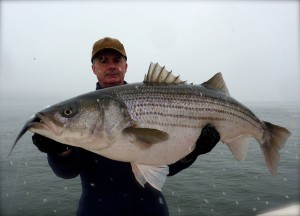 Fortunately, I was able to get out for a few hours this snowy weekend. I had planned to launch my center console Thunder Road, but my neighbor Mark called to say he was up for a trip if we wanted to go in his Parker. That was a no-brainer since he has a heated cabin. My buddy Jamie joined us. As thunder rumbled across the Chesapeake Bay, we broke through the ice at Queen Anne Marina and set off into the fog, rain, and snow. I’ll let the video tell the story with the caveat that jigging is very much a hit or miss enterprise this time of year. Just because fish are there one day doesn’t mean they will be the next. The best bet is to fish locations where the fish can find warmer water. Here’s the video report:
Fortunately, I was able to get out for a few hours this snowy weekend. I had planned to launch my center console Thunder Road, but my neighbor Mark called to say he was up for a trip if we wanted to go in his Parker. That was a no-brainer since he has a heated cabin. My buddy Jamie joined us. As thunder rumbled across the Chesapeake Bay, we broke through the ice at Queen Anne Marina and set off into the fog, rain, and snow. I’ll let the video tell the story with the caveat that jigging is very much a hit or miss enterprise this time of year. Just because fish are there one day doesn’t mean they will be the next. The best bet is to fish locations where the fish can find warmer water. Here’s the video report:
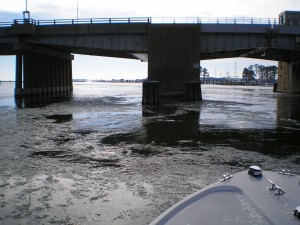 Catching striped bass in winter on the Chesapeake Bay isn’t easy. It’s not that the fish aren’t around because there are some to be caught. It’s just that it’s very hard to get to them. We’ve had an exceptionally cold December followed by multiple sub-freezing days in January. It’s also been very windy. The windows of light-tackle opportunity are frosted. Even on rare days when the weather is fishable it’s a challenge to get on the water because the boat launches around Kent Island have been iced in solid. Fortunately, we got a little warming trend this week, so a few ramps opened up. Read More!
Catching striped bass in winter on the Chesapeake Bay isn’t easy. It’s not that the fish aren’t around because there are some to be caught. It’s just that it’s very hard to get to them. We’ve had an exceptionally cold December followed by multiple sub-freezing days in January. It’s also been very windy. The windows of light-tackle opportunity are frosted. Even on rare days when the weather is fishable it’s a challenge to get on the water because the boat launches around Kent Island have been iced in solid. Fortunately, we got a little warming trend this week, so a few ramps opened up. Read More!
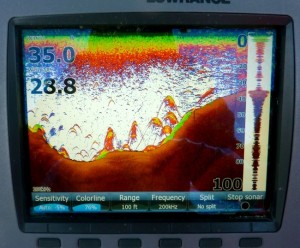 To fizz or not to fizz, that is the question a lot of yellow perch fishermen have been asking lately. As you can see by this sonar shot, yellow perch can hold in a wide range of depths this time of year in the Chesapeake Bay. At issue is that a few of the fish we catch from the deepest water come up with distended swim bladders. Since we inevitably land a few that are under the legal size limit, they have to be released. Because of all the air in their bodies, they can’t always swim back down. This leaves them floating on top of the water where they are vulnerable to birds and other predators. The practice of puncturing a fishes swim bladder with a hypodermic needle or other sharp object to relieve pressure is called fizzing. It works for some species, but for others it isn’t such a good idea. What about yellow perch? This week, I put the question to the experts. I spoke with several fisheries biologists I know, including some at the Maryland Department of Natural Resources. Here’s what I learned. Read More!
To fizz or not to fizz, that is the question a lot of yellow perch fishermen have been asking lately. As you can see by this sonar shot, yellow perch can hold in a wide range of depths this time of year in the Chesapeake Bay. At issue is that a few of the fish we catch from the deepest water come up with distended swim bladders. Since we inevitably land a few that are under the legal size limit, they have to be released. Because of all the air in their bodies, they can’t always swim back down. This leaves them floating on top of the water where they are vulnerable to birds and other predators. The practice of puncturing a fishes swim bladder with a hypodermic needle or other sharp object to relieve pressure is called fizzing. It works for some species, but for others it isn’t such a good idea. What about yellow perch? This week, I put the question to the experts. I spoke with several fisheries biologists I know, including some at the Maryland Department of Natural Resources. Here’s what I learned. Read More!
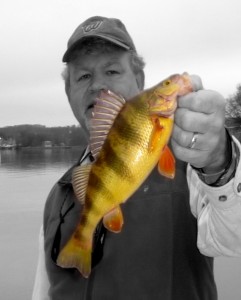 Ring perch, that’s what my fishing buddy Rich calls them, but considering the impact they’re having on the economy of the upper Chesapeake Bay, they might as well be called gold fish. If ever there was a Chesapeake fisheries management success story it’s what we are experiencing right now with yellow perch. As fishermen pour in from all over, posting one successful fishing report after another, it’s obvious that Maryland can proudly boast one of the best perch fisheries in the United States. I don’t know about you, but I consider that one heck of an accomplishment, and the Maryland Department of Natural Resources (DNR) should be proud. Unfortunately, it wasn’t always this way. For the past couple of decades yellow perch fishing has been a shadow of what it could be. As of 2005 there were few limits on the commercial harvest of yellow perch. Netters could set their traps almost wherever and whenever they wanted taking as many fish as they could catch. Almost all our Maryland fish were sold outside the state. The only benefit to our economy was in lining the pockets of a few commercial fishermen. In 2008, that all changed. Read More!
Ring perch, that’s what my fishing buddy Rich calls them, but considering the impact they’re having on the economy of the upper Chesapeake Bay, they might as well be called gold fish. If ever there was a Chesapeake fisheries management success story it’s what we are experiencing right now with yellow perch. As fishermen pour in from all over, posting one successful fishing report after another, it’s obvious that Maryland can proudly boast one of the best perch fisheries in the United States. I don’t know about you, but I consider that one heck of an accomplishment, and the Maryland Department of Natural Resources (DNR) should be proud. Unfortunately, it wasn’t always this way. For the past couple of decades yellow perch fishing has been a shadow of what it could be. As of 2005 there were few limits on the commercial harvest of yellow perch. Netters could set their traps almost wherever and whenever they wanted taking as many fish as they could catch. Almost all our Maryland fish were sold outside the state. The only benefit to our economy was in lining the pockets of a few commercial fishermen. In 2008, that all changed. Read More!
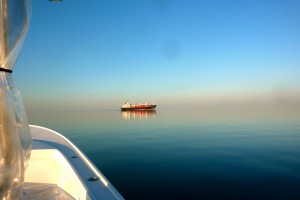 It’s been a windy December, so rough lately that it’s been hard to get out and fish. After yet another strong nor’easter blew through this week, the wind finally came down. Hoping for some cold weather catch & release action, my son Daniel and I broke the ice Wednesday and launched Thunder Road at the Shipping Creek ramp on Kent Island to do some Mid-Bay exploring. We didn’t find many fish – one twenty-four-inch striper to be exact – but we enjoyed our time on the water. The Chesapeake was as flat as I’ve ever seen it. We could see for miles across the glass. In places where we could get an unobstructed view of the horizon, we couldn’t tell where the water ended and the blue sky began. I’ve noticed that the waters of the Bay seem calmer and bluer on cold winter days. Sometimes I think I can see farther this time of year. It turns out there’s an interesting scientific explanation. Read More!
It’s been a windy December, so rough lately that it’s been hard to get out and fish. After yet another strong nor’easter blew through this week, the wind finally came down. Hoping for some cold weather catch & release action, my son Daniel and I broke the ice Wednesday and launched Thunder Road at the Shipping Creek ramp on Kent Island to do some Mid-Bay exploring. We didn’t find many fish – one twenty-four-inch striper to be exact – but we enjoyed our time on the water. The Chesapeake was as flat as I’ve ever seen it. We could see for miles across the glass. In places where we could get an unobstructed view of the horizon, we couldn’t tell where the water ended and the blue sky began. I’ve noticed that the waters of the Bay seem calmer and bluer on cold winter days. Sometimes I think I can see farther this time of year. It turns out there’s an interesting scientific explanation. Read More!
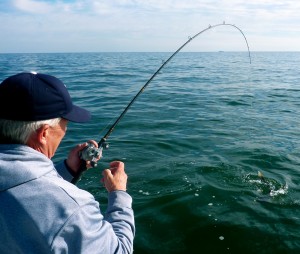 I recently discussed light tackle with some fishing buddies over a bottle of Tennessee’s finest. We all agreed that casting artificial lures on the Chesapeake Bay has the potential to catch as many big fish as any other method. I believe the chances for a trophy striper are better for those who know how to handle a light stick. Until a couple of years ago, most Mid-Atlantic fishermen would have laughed at a statement like that, but not anymore. Throughout 2010, light tackle casting held its own and often out-produced other methods of Chesapeake Bay fishing. It’s encouraging to walk into bait shops and tackle stores now and see Bass Kandy Delights, Bass Assassins, and top water plugs displayed prominently at the end of the aisles beside umbrella rigs and parachute lures. I’m very happy to promote light tackle fishing for one main reason – I don’t know a single light tackle fisherman who isn’t a conservationist. It is absolutely clear that anglers who cast artificial lures are hard-wired to protect the fish and to take care of the water they fish in. Read More!
I recently discussed light tackle with some fishing buddies over a bottle of Tennessee’s finest. We all agreed that casting artificial lures on the Chesapeake Bay has the potential to catch as many big fish as any other method. I believe the chances for a trophy striper are better for those who know how to handle a light stick. Until a couple of years ago, most Mid-Atlantic fishermen would have laughed at a statement like that, but not anymore. Throughout 2010, light tackle casting held its own and often out-produced other methods of Chesapeake Bay fishing. It’s encouraging to walk into bait shops and tackle stores now and see Bass Kandy Delights, Bass Assassins, and top water plugs displayed prominently at the end of the aisles beside umbrella rigs and parachute lures. I’m very happy to promote light tackle fishing for one main reason – I don’t know a single light tackle fisherman who isn’t a conservationist. It is absolutely clear that anglers who cast artificial lures are hard-wired to protect the fish and to take care of the water they fish in. Read More!


